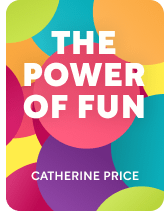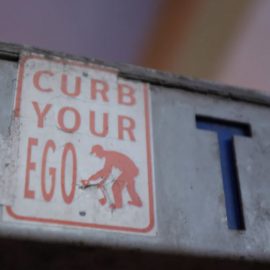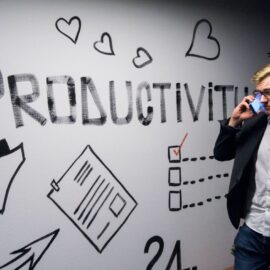

This article is an excerpt from the Shortform book guide to "The Power of Fun" by Catherine Price. Shortform has the world's best summaries and analyses of books you should be reading.
Like this article? Sign up for a free trial here.
Do you live a lackluster life? What if you could attract more fun into your life? Where should you start?
For many of us, as we get older, fun starts to take a backseat to the neverending list of adult responsibilities. But, it doesn’t have to be that way. Catherine Price shows you how to make time for fun, find your passions, become a fun person, push boundaries, and stay committed to having fun.
Continue reading to learn how to have fun in life with Price’s five recommendations.
How to Have Fun in Life
Price explains that you don’t just start having more fun because you’ve decided to: You also need to create the conditions that are conducive to fun. Price shares her advice on how to have fun in life. She recommends following these five steps: Make time, find your passions, invite fun, push boundaries, and stay committed.
#1: Make Time
If you’re going to prioritize fun, you need to make space for it to happen. The first step in making time is to give yourself permission to have fun. Many of us have been socialized to think of fun as self-indulgent or unproductive; we are convinced that our time would be better spent in more serious (often work-related) pursuits. But Price reiterates that fun isn’t at odds with being a hard worker or making the world a better place. In fact, she adds, fun might actually support you to do these things better by helping you feel more energized, inspired, and creative.
After you give yourself permission to have fun, think about how you can free up time in your day for fun. This might mean focusing on your high-impact tasks at work, saying no to obligations that aren’t necessary or fun, and setting boundaries with your phone and other devices. When you don’t fill your day with busy work, unnecessary obligations, or screens, you might be surprised at how much time you get back.
You might need some help making time for fun. If you’re a parent or in a relationship, ask your family for support. Have a conversation with your partner about how you’re sharing the burden of the mental and emotional labor of your household. Then carve out space for each of you to have independent fun every week. This will create a virtuous cycle of goodwill that you’ll both continue to benefit from.
#2: Find Your Passions
Price recommends you use your reclaimed time to pursue your passions, which she defines as activities or hobbies that focus your attention and leave you feeling invigorated. Not everything you love to do is a passion. For example, you may love taking baths, but this is an activity that relaxes you, not one that inspires you; therefore it doesn’t qualify as a passion.
Price explains that our passions are often a great jumping-off point for True Fun because they lend themselves to opportunities for playfulness, connection, and flow. Passions are playful because they’re voluntary and pursued for their own sake. They also often lead you to meet new people and make new connections, and they facilitate building skills and knowledge that allow you to experience flow.
If you’ve lost touch with what you’re passionate about, Price offers some guiding questions to help you get started:
- What are you interested in learning?
- What’s something you used to love but stopped doing?
- What’s something you’ve always wanted to try but never felt like you could?
- What’s something you do that lights you up?
Price recommends you brainstorm as many ideas as possible and then choose something (anything) to try. Even if it’s not the right fit, you’ll have learned something about yourself in the process.
Price cautions that many people avoid pursuing their passions because they’re afraid of looking stupid or being bad at something. She says that if you’re trying something new, you probably will be bad at it, but she offers the reassurance that, if you stick with it through the awkward beginner phase, you may discover a new passion (and a potential source of True Fun).
#3: Invite Fun
You’ll also inevitably have more fun if you become someone who attracts fun to you. For many of us, when someone describes “a fun person,” they picture a person standing on a table in the middle of a party convincing everyone to play charades. But, what if playing charades isn’t your cup of tea? According to Price, not a problem. Price explains that you don’t have to be “the life of the party” or even an extrovert, to be considered fun. When asked to describe someone as fun, people describe a person who makes them feel included, laughs easily, and isn’t afraid to try new things or be silly. These are qualities that you can have regardless of where you fall on the introverted/extroverted spectrum.
Price identifies two ways you can become more fun: You can adopt a fun attitude, and you can create a fun environment.
To adopt a fun attitude, you need to practice noticing or seeking out opportunities for fun, however small. The ability to laugh at yourself, to look for the absurd in the ordinary, to smile more, to be present, and to notice unexpected and delightful moments of pleasure are all examples of ways to hone your fun radar.
You can also facilitate environments that are conducive to fun (what Price refers to as “playgrounds”). Fun environments are spaces where there’s an understanding that the space is meant to be fun, where everyone is 100% in, and where judgment isn’t welcome. Your fun environment might be a dinner club with friends, a virtual Dungeons & Dragons tournament, or an adult kickball league. The activity doesn’t matter, as long as the space invites people to let go and be themselves.
#4: Push Boundaries
In her research, Price noticed an unexpected theme in many people’s experiences of True Fun. She found that fun often goes hand-in-hand with breaking rules, however harmless. She explains that play is often about behaving outside the norms of expected behavior or social structure, which often means engaging in small acts of rebellion.
But, as Price explains, to push boundaries, you need something to push against. She offers a few suggestions of opportunities to push back and suggests finding mini acts of resistance that fit your personality.
You can push back against established patterns (what Price calls “habits and routines”). Many of us operate under a predictable schedule. You can rebel against this predictability by breaking with your normal pattern and introducing some novelty into your day. This can be as simple as changing up your regular takeout spot or taking a walk after dinner instead of turning on a TV show.
Similarly, you can push back against traditions. Traditions are a powerful tool of connection, but only when you get to choose them. Changing traditions that you don’t like or that are no longer fun is a prime opportunity for rebellion.
#5: Stay Committed
The last step of sparking more fun is committing to it. Price insists that to have fun, you have to prioritize fun—not once, but over and over. She outlines several steps you can take to ensure that you continue to keep fun at the top of your priority list.
First, find your people (what Price calls your “fun squad”). This is a group of people that help you have fun, either by holding you accountable to make time for fun or by having fun with you. You might already have a group of people in mind, or you might need to create one. Either way, fellow fun lovers are a key resource in your effort to prioritize fun.
(Shortform note: When it comes to forming your group of people, more isn’t necessarily better. Consider how you plan on using this group. For example, if the focus is accountability, consider limiting your group to four or five people. Research suggests that groups of five or fewer are more conducive to conversation. However, if you plan on forming a soccer team, you’ll probably need a few more friends.)
Next, prioritize the things in your life that tend to lead to fun (what Price calls your “fun magnets”). Make an effort to spend time around the people, in the places, or doing the activities that you know tend to lead to fun. The more time you spend with things or people that lead to fun, the higher the likelihood that fun will ensue.
(Shortform note: Prioritizing the things in your life that are fun will often mean saying no to things that aren’t fun or necessary (for example, being on an extra committee at work). In Essentialism, Greg McKeown argues that saying no is an essential skill when you’re trying to refocus your time and energy on your biggest priorities. Acknowledging that people often are uncomfortable saying no, he offers several helpful tips. First, remember you’re saying no to a proposal, not a person. Second, know that saying no to one thing allows you to say yes to something else. And third, don’t put off the conversation. Be direct. People will appreciate your candor.)
Price also recommends incorporating different levels of fun in your life. That means making an effort to have daily and weekly fun fixes but also prioritizing opportunities for more time-intensive experiences that leave you feeling energized and rejuvenated. For example, if you love playing in the water, you might join a weekly water aerobics class but also plan an annual rafting trip with your closest friends.
(Shortform note: Rubin makes a similar recommendation in The Happiness Project, emphasizing that it’s possible to infuse your day with small moments of fun simply by allowing time for goofiness. She explains that many people, consciously or unconsciously, shut down moments of goofiness or play because they feel busy or rushed. When you catch yourself sacrificing fun for efficiency, she recommends asking “Does this need to be done now?” and “Can we spare time to be goofy?” If you can, then do it. You, and everyone around you, will have more fun as a result.)
These bigger experiences often require a bigger financial and time commitment. Price explains that prioritizing fun sometimes requires an investment, but she emphasizes that investing in experiences (instead of stuff) will have a bigger impact on your happiness.
| Why Experiences Make You Happier Than Stuff The illusion that more stuff will bring you more happiness is referred to as the “paradox of possession.” Psychologists have identified three reasons why the happiness that we get from acquiring new possessions is fleeting and ultimately unsatisfying. • The novelty of new stuff quickly wears off. We become accustomed to new possessions, and what once seemed exciting or different becomes normal and routine. • It fuels our desire for more or better. Our purchases set new standards, leading us to seek out even better possessions as we get used to the ones we have. • We get jealous. Owning possessions naturally encourages us to compare ourselves to others, making us jealous when other people have better or more impressive things than we do. On the other hand, research has found that experiences lead to more and longer-lasting happiness. Experiences, unlike our possessions, become a part of our identity and therefore we value them more deeply. Furthermore, experiences are subjective, making them less likely to invite comparison. The anticipation of and memory of experiences also adds to their enjoyment, while the anticipation of stuff makes us feel impatient and often doesn’t live up to expectations. |
Finally, use technology in a way that increases fun in your life rather than distracting you from it. Price recommends assessing your relationship to your devices and implementing extended screen-free periods in your life.
(Shortform note: Before writing The Power of Fun, Price wrote How to Break Up With Your Phone, which offers a 30-day step-by-step plan on how to build a different relationship with your smartphone. Price begins by recommending that you become more aware of when you use your phone and why, including installing a screen time tracker app. She then outlines daily incremental steps you can take to practice using your phone intentionally rather than out of habit. The plan culminates with a digital sabbath in which you practice spending 24 hours without your smartphone.)

———End of Preview———
Like what you just read? Read the rest of the world's best book summary and analysis of Catherine Price's "The Power of Fun" at Shortform.
Here's what you'll find in our full The Power of Fun summary:
- Why fun is fundamental to living a happy and healthy life
- How modern society has made it harder to prioritize fun
- A step-by-step guide to invite more fun into your life







Heya.
In order to have fun these are my ideas. You can go to the nearest beach in question for a entire day out. Eat a family picnic as well. Or you can explore the sea front as well. Put two ham and cheese sandwiches in a bag and take a entire cake too. You can also take other things like cheese fondue, tarts and so on. Best wishes. Have a map to use.
Additional things to consider here include the entry times. Bring a decent camera. Research the museum in advance. Look carefully at the information on the official website, call or email the museum staff for more details in advance. This is always a good idea.
Spend a whole day in a good local museum. Make sure to have a full tour of the place. Eat at the museum cafe. Get some colourful photos and try to visit the museum gift store. Look all around the place. Again take a working camera and a free packed lunch. I relied too much on a free packed lunch to eat. I wish I didn’t bother half of the time.
I used to take two cheese and ham sandwiches in with me on the actual day for a quick lunch at half eleven. I also brought a few bottles of water in case to sip. Order food wisely. Don’t rush ever. Take your time. I wish I had researched pubs and cafes instead. I hardly did. That was my mistake. I wanted to save money.
Visit a farm. Do the same thing. Don’t buy food there. Avoid that if possible at all costs. Instead take a free packed lunch with you to eat. I always made sandwiches myself on the Friday night before. Then I stuffed them in a box or tin to eat whilst we were there. That was fun. Make biscuits. Eat them.
After a proper weekend out we came back and I watched a film with a decent glass of white wine on Sunday evening. The children both fell asleep in their beds. I relaxed with a glass of white wine at night after dinner was over later on. But not always. All plans were made long in advance.
We usually had a busy weekend away at a cheap hotel in another town. It was not cheap at all. Far from it in fact. So I had to reuse our old water bottles and make do with what we had in terms of the food. Often we had mini sausage or bread rolls with fresh fruit and cool lemonade. Occasionally we had ham and cheese sandwiches, a cake and two filled up bottles of water. I always had a map to use. We used it all the time. It always saved us a lot of time.
Sometimes I had made us a tray of brownies, tarts or a pie for lunch. With that we had lemonade in a cup. From time to time I took along brownies or a pie to eat. At other times I prepared two muffins or bread rolls which I transported in a tin. Not very often, I took a bottle of juice and the leftover food. This included biscuits. I picked us a few free strawberries to eat on the picnic. Try a mug cake.
Once a year we munched tasty fish and chips on the sea front. Before we went back to the beachside hotel that is. Oh yes I booked a cheap hotel room in advance. We usually had a half a lovely pie with us that was wrapped up. And a free cake. Once a year we had a cheap ice cream and tried our hand at the beach sports. You can buy it there quite easily.